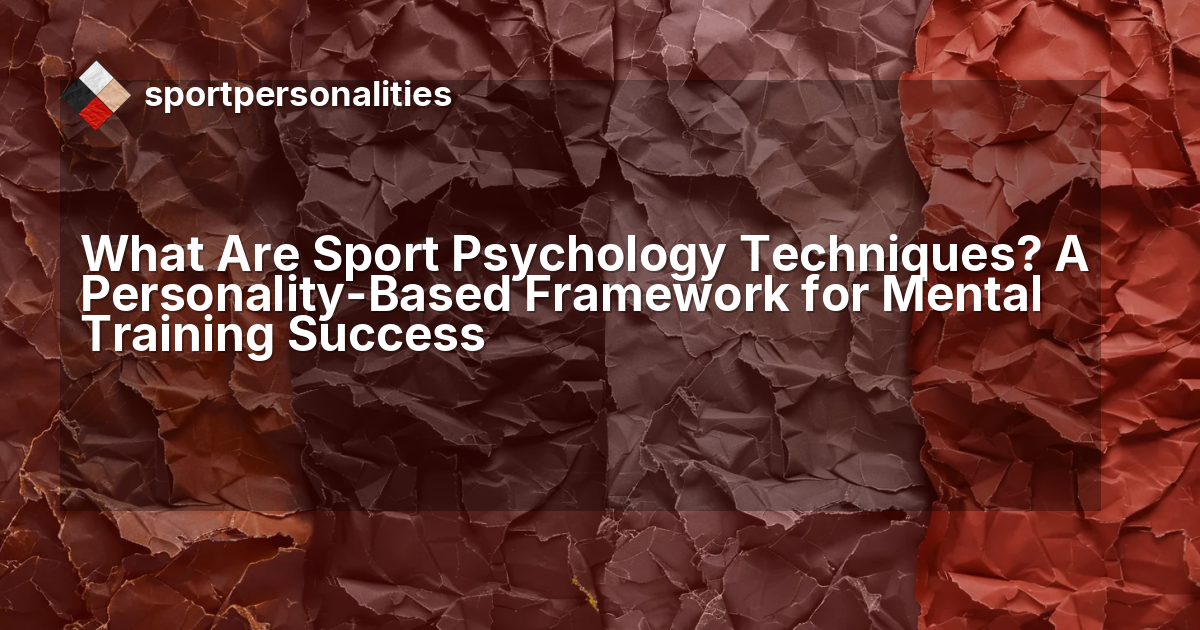What Are Sport Psychology Techniques? The Four Pillars Approach to Mental Mastery
Every athlete understands that training the body is only half the battle. The unseen factor , what happens between your ears , often determines who wins, who fades, and who chokes. Sport psychology techniques are the tools we use to align mind and body. But here’s a critical insight most mental training guides leave out: a technique only works when it fits your psychological wiring. What calms one athlete may derail another.
This article walks through sport psychology techniques not as generic tools, but as arms of a system shaped by your personality architecture. You’ll see how each method fits into four pillars of mental performance, and get exact guidance for four distinct sport profiles. The aim: not to smash you into a one-size box, but to help you apply what truly works for you.
Core Insight
What Sport Psychology Techniques Do, in Practice
Sport psychology techniques are structured mental strategies that help athletes regulate arousal, focus attention on performance-relevant cues, build durable confidence, and recover mentally after setbacks. Unlike physical conditioning that targets muscles and energy systems, these methods shape the mental patterns that determine whether your body expresses its true capacity when it counts.
- Mental imagery / visualization: rehearsing movements, tactics, and conditions.
- Self-talk & cognitive reframing: instructional cues and belief adjustments.
- Goal-setting frameworks: outcome, performance, and process layers.
- Arousal regulation: breathing protocols, progressive muscle relaxation, mindfulness.
- Attentional control: anchors, re-centering cues, distraction management.
- Pre-performance routines: consistent triggers that prime execution on demand.
The Four Pillars: How Personality Filters Technique Effectiveness
The SportPersonalities framework explains why the same method can elevate one athlete and unsettle another. Align each technique with these four dimensions.
Four Pillars , At a Glance
- Cognitive Style (Reactive ↔ Tactical): Reactive = short, sensory cues and intuitive flow. Tactical = structured plans, scenario trees, explicit self-talk.
- Competitive Focus (Self-Referenced ↔ Other-Referenced): Self-Referenced = progress against personal standards, process goals. Other-Referenced = rivalry framing, opponent analysis.
- Drive (Intrinsic ↔ Extrinsic): Intrinsic = meaning, mastery, satisfaction. Extrinsic = recognition, rankings, visible metrics.
- Social Style (Autonomous ↔ Collaborative): Autonomous = private routines, solo logs. Collaborative = shared routines, team huddles, social accountability.
Techniques, Decoded by Pillar
Mental Preparation
Visualization / Mental Imagery. Tactical athletes benefit from branching scenario work, opponent tendencies, time-and-score situations, and decision trees. Reactive athletes thrive on short, movement-led imagery that emphasizes tempo, timing, and feel over plot. Both aim at fidelity: rehearse what you will actually do, at the speed you will do it.
Pre-performance self-talk. Tactical profiles prefer structured instructions (“If X, then Y; check shoulder; scan; decide”). Reactive profiles prefer brief, permissive cues (“Trust first read,” “Snap and go”). Keep phrases concrete and portable.
Emotional Regulation
Breathing & Progressive Muscle Relaxation. Tactical athletes often settle with counted protocols (e.g., box breathing, full PMR sequences). Highly reactive competitors may only need a few deliberate exhales or a 10–20 second micro-scan to avoid dulling competitive sharpness.
Mindfulness & body scanning. Useful for quieting analysis spirals and re-anchoring in sensation. For some profiles, a brief sensory check (“feet-ground-breath”) outperforms long meditations on game day.
Performance Optimization
Attention anchors. Choose one cue per phase: a breath point, a visual target, or a concise phrase. When focus slips, return to  The Anchor (ISTC) once, then act.
The Anchor (ISTC) once, then act.
Routines & triggers. Tactical athletes tolerate richer routines (visual checks, cues, sequence). Reactive athletes do better with light, rhythmic triggers that avoid overthinking while preserving intensity.
Recovery & Resilience
Reflective journaling & debriefs. Autonomous athletes may prefer concise private logs; collaborative athletes benefit from short group debriefs that turn emotion into action steps.
Cognitive reframing. Translate outcomes into information. Replace “I choked” with “Under pressure, tempo slowed at phase three, train the transition.” Keep it observable and specific.
Implementation Cue
Archetype-Specific Applications
These four case studies show how the same technique category changes character by personality. (Your site auto-links sport profile names.)
 The Duelist (IOTA)
The Duelist (IOTA)
- Preparation: opponent film review; “if–then” visualization trees; solitary tactical walk-throughs.
- Self-talk: precise process cues (“Shape the angle,” “Close air, force baseline”).
- Routine: detailed warm-up checklist; quiet pre-start buffer.
- Recovery: private technical journaling; limited group emotion processing.
 The Captain (EOTC)
The Captain (EOTC)
- Preparation: team scenario mapping; role clarity; set-piece coordination.
- Self-talk: leadership cues (“Set the tone,” “Execute together”).
- Routine: brief huddles; shared checkpoints; final call-and-response.
- Recovery: group debriefs; recognition tied to standards and results.
 The Flow-Seeker (ISRA)
The Flow-Seeker (ISRA)
- Preparation: sensation-first imagery; rhythm and timing rehearsals; environmental feel.
- Self-talk: permission cues (“Let it unfold,” “Feel the line”).
- Routine: short sensory grounding; avoid heavy scripting.
- Recovery: reflective observation; keep analysis light after both wins and losses.
 The Sparkplug (ESRC)
The Sparkplug (ESRC)
- Preparation: group warm-ups; momentum imagery including teammates and crowd energy.
- Self-talk: competitive cues (“Ignite the run,” “Win the moment”).
- Routine: high-energy triggers; brief call-and-response cadence.
- Recovery: shared reflection; external reinforcement and next-target framing.
When Good Techniques “Fail”
Perceived failure is usually a fit problem, not a flawed method. Audit against the Four Pillars.
- Breathing drills can steady Tactical athletes yet under-arouse highly Reactive ones. Solution: shorten to a few deliberate exhales or pair with dynamic movement.
- Outcome-framed self-talk can motivate Extrinsic athletes but pressure Intrinsic ones. Solution: rephrase to mastery/process language.
- Group visualization energizes Collaborative profiles but can feel intrusive to Autonomous ones. Solution: keep their imagery private and concise.
Your Personalized Mental Training System
- Map your Pillars. Note where you sit on each continuum: Reactive/Tactical, Self-/Other-Referenced, Intrinsic/Extrinsic, Autonomous/Collaborative.
- Select two core techniques. Pick the highest-fit pair (e.g., visualization + anchor, or breathing + routine). Add a third only after two are automatic.
- Embed in existing moments. Warm-up = anchor and cue check; travel = visualization; cooldown = short reflection.
- Track by personality. Autonomous = private log; Collaborative = shared tracker; Extrinsic = visible metrics; Intrinsic = quality-of-engagement notes.
- Stress-test, then refine. Rehearse under fatigue and time limits. Trim wording, steps, or timing until it holds under pressure.
- Expand your range. Build one alternate technique per pillar for situations that demand a different state (e.g., rivalry, team finals).
Discover Your Own Sport Profile
This article explores one of 16 profiles. Find out which one you are and unlock a personalized blueprint for your athletic journey.
Take the Free TestWhy Personalization Wins
Generic advice scales, but it rarely sticks. The sustainable advantage comes from methods that respect how you actually operate. Tactical athletes shouldn’t be forced into reactive rituals; reactive athletes don’t need dense scripts to justify their instincts. Intrinsic competitors need meaning to fuel repetition; extrinsic competitors need visible stakes. Autonomous athletes do their best work in quiet; collaborative athletes sharpen in connection.
Mental mastery isn’t about changing who you are. It’s about understanding your wiring well enough to stop fighting it. Start with fit, protect consistency, and let performance compound.
This content is for educational purposes, drawing on sport psychology research and professional experience. I hold an M.A. in Social Psychology, an ISSA Elite Trainer and Nutrition certification, and completed professional training in Sport Psychology for Athlete Development through the Barcelona Innovation Hub. I am not a licensed clinical psychologist or medical doctor. Individual results may vary. For clinical or medical concerns, please consult a licensed healthcare professional.











